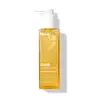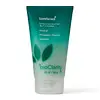What's inside
What's inside
 Key Ingredients
Key Ingredients

 Benefits
Benefits

 Concerns
Concerns

 Ingredients Side-by-side
Ingredients Side-by-side

Water
Skin ConditioningDecyl Glucoside
CleansingCocamidopropyl Betaine
CleansingHydroxypropyl Starch Phosphate
Butylene Glycol
HumectantGlycolic Acid
BufferingGlycerin
HumectantMandelic Acid
Antimicrobial1,2-Hexanediol
Skin ConditioningSodium Hydroxide
BufferingSodium Chloride
MaskingTromethamine
BufferingAmorphophallus Konjac Root Powder
AbrasiveGluconolactone
Skin ConditioningCitrus Junos Fruit Extract
Skin ConditioningAnanas Sativus Fruit Extract
Skin ConditioningSalix Alba Bark Extract
AstringentHamamelis Virginiana Extract
AntiseborrhoeicLactobacillus/Rice Ferment
Skin ConditioningBifida Ferment Lysate
Skin ConditioningSalvia Officinalis Leaf Extract
CleansingSodium Hyaluronate
HumectantHyaluronic Acid
HumectantHydrolyzed Hyaluronic Acid
HumectantHydrolyzed Sodium Hyaluronate
Skin ConditioningHydroxypropyltrimonium Hyaluronate
Potassium Hyaluronate
Skin ConditioningSodium Acetylated Hyaluronate
HumectantZinc PCA
HumectantMaltitol
HumectantAllantoin
Skin ConditioningSodium Hyaluronate Crosspolymer
HumectantXanthan Gum
EmulsifyingArginine
MaskingPentylene Glycol
Skin ConditioningEthylhexylglycerin
Skin ConditioningWater, Decyl Glucoside, Cocamidopropyl Betaine, Hydroxypropyl Starch Phosphate, Butylene Glycol, Glycolic Acid, Glycerin, Mandelic Acid, 1,2-Hexanediol, Sodium Hydroxide, Sodium Chloride, Tromethamine, Amorphophallus Konjac Root Powder, Gluconolactone, Citrus Junos Fruit Extract, Ananas Sativus Fruit Extract, Salix Alba Bark Extract, Hamamelis Virginiana Extract, Lactobacillus/Rice Ferment, Bifida Ferment Lysate, Salvia Officinalis Leaf Extract, Sodium Hyaluronate, Hyaluronic Acid, Hydrolyzed Hyaluronic Acid, Hydrolyzed Sodium Hyaluronate, Hydroxypropyltrimonium Hyaluronate, Potassium Hyaluronate, Sodium Acetylated Hyaluronate, Zinc PCA, Maltitol, Allantoin, Sodium Hyaluronate Crosspolymer, Xanthan Gum, Arginine, Pentylene Glycol, Ethylhexylglycerin
Water
Skin ConditioningPoloxamer 184
EmulsifyingCoco-Caprylate/Caprate
EmollientSodium Polyacrylate
AbsorbentCoconut Alkanes
EmollientPropanediol
SolventBetaine
HumectantChlorophyllin-Copper Complex
AntioxidantBromelain
Skin ConditioningPapain
Skin ConditioningSqualane
EmollientMorus Alba Leaf Extract
Skin ConditioningSodium Hyaluronate
HumectantCucumis Sativus Fruit Extract
EmollientAloe Barbadensis Leaf Juice Powder
Skin ConditioningEthylhexylglycerin
Skin ConditioningHelianthus Annuus Seed Oil
EmollientCarthamus Tinctorius Seed Oil
MaskingTocopherol
AntioxidantPyrus Malus Fruit Extract
Skin ConditioningPhosphatidylcholine
EmulsifyingGlycerin
HumectantParfum
MaskingPanthenol
Skin ConditioningIsopentyldiol
HumectantMaltodextrin
AbsorbentPhenoxyethanol
PreservativeXanthan Gum
EmulsifyingCitric Acid
BufferingLinalool
PerfumingHexyl Cinnamal
PerfumingCitral
PerfumingEugenol
PerfumingWater, Poloxamer 184, Coco-Caprylate/Caprate, Sodium Polyacrylate, Coconut Alkanes, Propanediol, Betaine, Chlorophyllin-Copper Complex, Bromelain, Papain, Squalane, Morus Alba Leaf Extract, Sodium Hyaluronate, Cucumis Sativus Fruit Extract, Aloe Barbadensis Leaf Juice Powder, Ethylhexylglycerin, Helianthus Annuus Seed Oil, Carthamus Tinctorius Seed Oil, Tocopherol, Pyrus Malus Fruit Extract, Phosphatidylcholine, Glycerin, Parfum, Panthenol, Isopentyldiol, Maltodextrin, Phenoxyethanol, Xanthan Gum, Citric Acid, Linalool, Hexyl Cinnamal, Citral, Eugenol
 Reviews
Reviews

Ingredients Explained
These ingredients are found in both products.
Ingredients higher up in an ingredient list are typically present in a larger amount.
Ethylhexylglycerin (we can't pronounce this either) is commonly used as a preservative and skin softener. It is derived from glyceryl.
You might see Ethylhexylglycerin often paired with other preservatives such as phenoxyethanol. Ethylhexylglycerin has been found to increase the effectiveness of these other preservatives.
Glycerin is already naturally found in your skin. It helps moisturize and protect your skin.
A study from 2016 found glycerin to be more effective as a humectant than AHAs and hyaluronic acid.
As a humectant, it helps the skin stay hydrated by pulling moisture to your skin. The low molecular weight of glycerin allows it to pull moisture into the deeper layers of your skin.
Hydrated skin improves your skin barrier; Your skin barrier helps protect against irritants and bacteria.
Glycerin has also been found to have antimicrobial and antiviral properties. Due to these properties, glycerin is often used in wound and burn treatments.
In cosmetics, glycerin is usually derived from plants such as soybean or palm. However, it can also be sourced from animals, such as tallow or animal fat.
This ingredient is organic, colorless, odorless, and non-toxic.
Glycerin is the name for this ingredient in American English. British English uses Glycerol/Glycerine.
Learn more about GlycerinSodium Hyaluronate is hyaluronic acid's salt form. It is commonly derived from the sodium salt of hyaluronic acid.
Like hyaluronic acid, it is great at holding water and acts as a humectant. This makes it a great skin hydrating ingredient.
Sodium Hyaluronate is naturally occurring in our bodies and is mostly found in eye fluid and joints.
These are some other common types of Hyaluronic Acid:
Learn more about Sodium HyaluronateWater. It's the most common cosmetic ingredient of all. You'll usually see it at the top of ingredient lists, meaning that it makes up the largest part of the product.
So why is it so popular? Water most often acts as a solvent - this means that it helps dissolve other ingredients into the formulation.
You'll also recognize water as that liquid we all need to stay alive. If you see this, drink a glass of water. Stay hydrated!
Learn more about WaterXanthan gum is used as a stabilizer and thickener within cosmetic products. It helps give products a sticky, thick feeling - preventing them from being too runny.
On the technical side of things, xanthan gum is a polysaccharide - a combination consisting of multiple sugar molecules bonded together.
Xanthan gum is a pretty common and great ingredient. It is a natural, non-toxic, non-irritating ingredient that is also commonly used in food products.
Learn more about Xanthan Gum